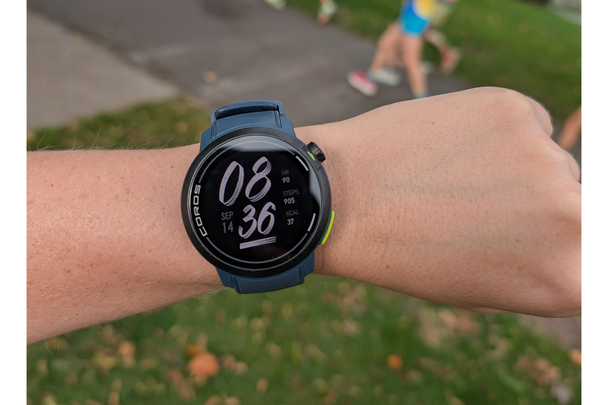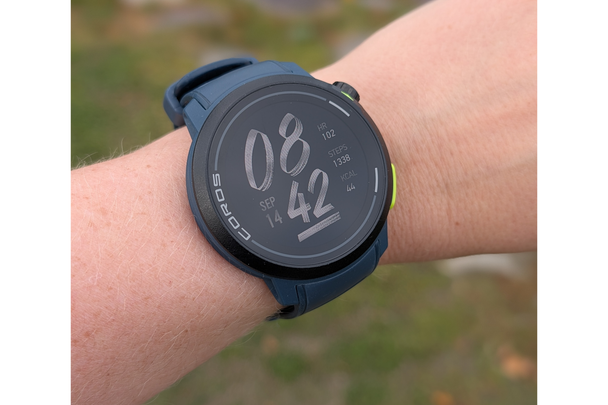The main reason to buy a running watch is to track your runs, so you want it to perform at this very basic level. The all-satellite dual-frequency GPS on the Coros pace pro watch is one of the most reliable I’ve tested. I live near a cluster of buildings that cause most trackers to lose track, but the pace pro always shows right where I am, down to a foot or two. Plus, it’s quick to connect. I’ve never waited more than about six seconds for a signal, but it’s usually ready to go in just a couple of seconds.
The Coros pace pro is the first watch I’ve ever consistently used for pre-programming speed workouts with various intervals at different paces or effort levels. That’s because Coros makes it exceptionally easy to create and sync a workout from the app, then follow along on your wrist. A pace alert will keep me honest about my speed — in a gentle, non-irritating way — while a colored graph lets me easily check on my heart rate at a glance. (Particularly since the bright, AMOLED display makes it easy to see in any lighting scenario, whether I’m out at midday in the sun, or it’s after dark.)

I also love that it provides access to coach-designed workouts and entire training plans for everything from a 5k to a marathon — all of which can be customized to your goals and fitness level. I’ve followed a couple of these and found them well-designed and a super helpful way to train.
Once I’ve finished a run, there’s a whole bunch of data to scroll through right on the watch screen. In addition to pace and distance, it presents mile-by-mile breakdowns of heart rate, stride length, and running power, plus the projected recovery time. It also estimates race-readiness, predicts finish times of various distances, and tells me whether my fitness is increasing — surprisingly addicting stats to pay attention to, even if experts say you should take them with a grain of salt.
Although it’s priced as a mid-range watch, the features of the Coros pace pro are honestly closer to what you’d find on the premium end of the spectrum. Notably, the offline maps provide turn-by-turn navigation, off-course alerts, and back-to-start assistance. You can create your own route in the app or import a GPX file, then get prompts on exactly where to head without having to stop and check your phone. While I don’t use this feature a lot because (unlike with workouts) it takes a while to create a route, I liked having the option if I need it. My trail-running-loving husband, who often gets lost in the woods — and has his own pace pro — swears by it.

The Coros pace pro is not my favorite all-day fitness tracker I’ve worn (that distinction goes to the Garmin forerunner 265). Although it’s lightweight, the bulky design takes up a good deal of real estate on the wrist, and looks a little too utilitarian to dress up with nicer outfits. And while it does measure some helpful information, such as steps taken, breath rate, oxygen saturation, and gives an overall stress rating throughout the day, I find the sleep tracking isn’t reliable enough to be worth going to bed with. (It sometimes clocks time I spend doomscrolling as “light sleep,” and doesn’t always pick up on naps.) It also doesn’t offer contactless payments like most high-end smartwatches these days.
The music feature — something I was initially looking forward to — is also underwhelming. Although you get 32GB for storing offline music, it only works with MP3 files. As someone who mainly streams Spotify and stopped downloading tracks years ago, that leaves me with very few options. Plus, I have to turn off my phone’s Bluetooth to get a clear connection between my watch and headphones, so after a few annoying tests, I stopped trying.
But while those features are nice-to-haves, I personally don’t really need them. Something that’s much more important, I’ve found, is battery life — an area where the Coros pace pro definitely excels. A watch you have to constantly recharge is a watch you’ll likely end up leaving at home. Coros is known for creating watches that last a long time, and the pace pro is no different. The brand says you can get up to 20 days of daily use between charges, and I’ve found that an hour-long run only eats up four percent of the battery. That gives me more than enough time to run as long as I want to.



0 Comments